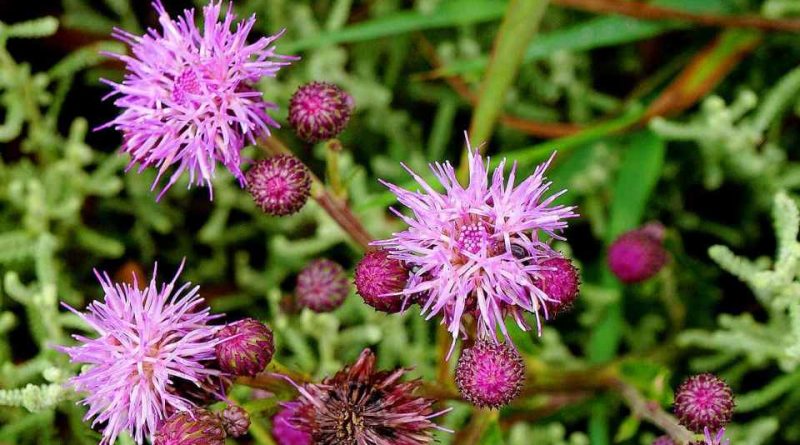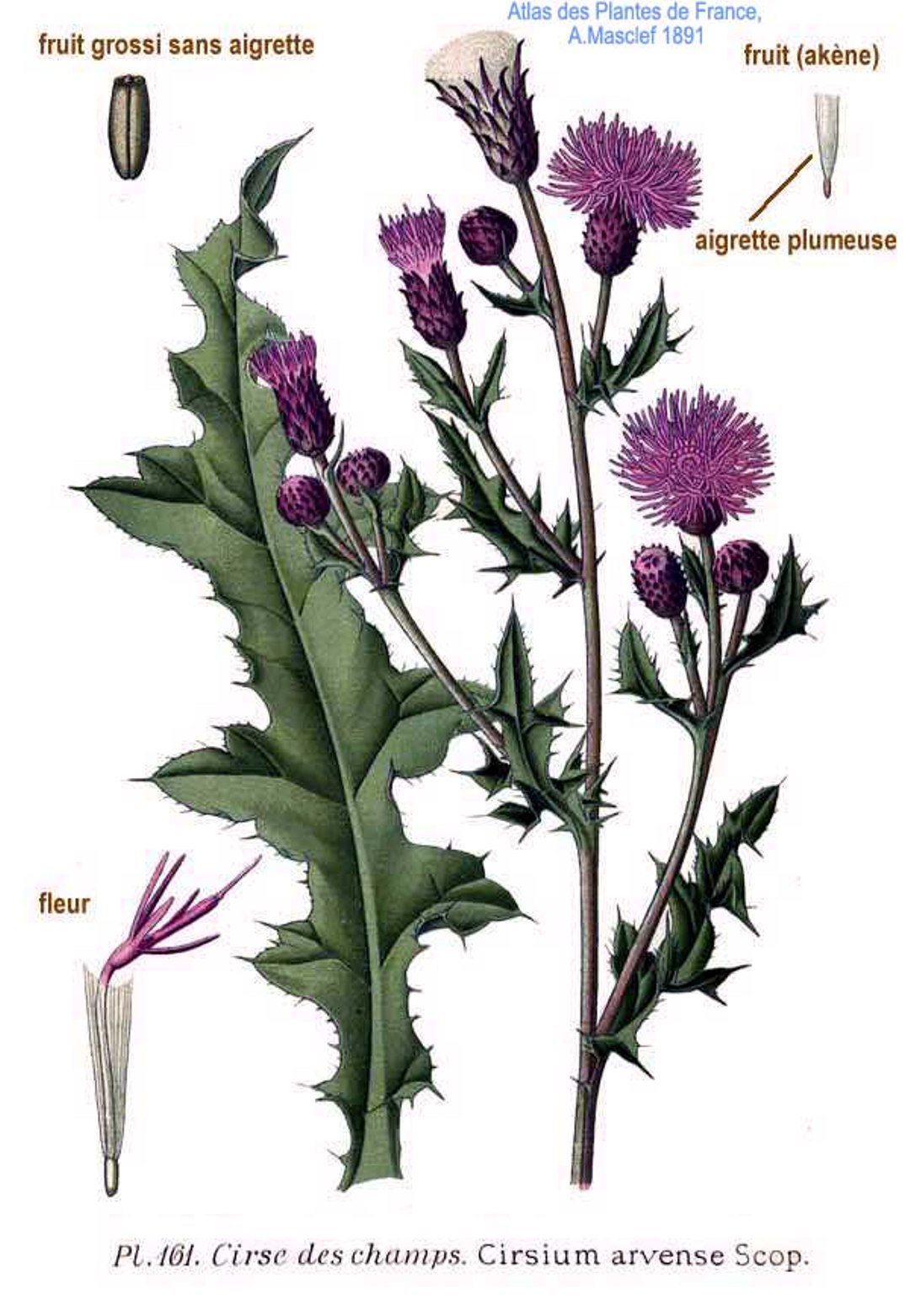Cirsium arvense
Cirsium arvense
The field thistle (Cirsium arvense (L.) Scop.) is a herbaceous species belonging to the Asteraceae family.
Systematics –
From the systematic point of view it belongs to the Eukaryota Domain, Kingdom Plantae, Magnoliophyta Division, Magnoliopsida Class, Asterales Order, Asteraceae Family, Cichorioideae Subfamily, Cardueae Tribe, Carduinae Sub-tribe and therefore to the Cirsium Genus and to the C. arvense Species.
The terms are synonymous:
– Breea arvensis Less;
– Breea incana (Gmel.) W.A. Weber;
– Carduus arvensis (L.) Robson .;
– Cirsium incanum (Gmel.) Fisch .;
– Cirsium setosum (Willd.) Bess. ex Bieb .;
– Serratula arvensis L ..
Etymology –
The term Cirsium comes from the Greek κίρσιον kírsion cardone and this from κρισός kirsós varice, swelling of the veins: this pathology was once treated with plants belonging to this genus.
The specific arvense epithet comes from arvum campo, arable land: arable land, referring to the growing environment.
Geographic Distribution and Habitat –
The field thistle is a native species of the Mediterranean area and, more precisely, of the area of southern Europe, North Africa and the Middle East.
In Italy it is present in all regions, including the islands.
This species, introduced by man in America, has actually become a pest in Brazil, Canada and the United States.
Its habitat is in ruderal or arvensi associations, along the roads, in landfills and clearings of woods, on rather deep and humiferous clayey soils, rich in nitrogen compounds, from fresh to subarid, sometimes decalcified, from sea level to the subalpine belt, up to 1750 m. sl.m ..
Description –
Cirsium arvense is a perennial herbaceous plant with an erect, longitudinally furrowed, pubescent stem that can reach 1-1.5 m in height.
The leaves are pinnate-lobed, pubescent, up to 20 cm long and 2–3 cm broad and have a toothed-thorny margin.
The inflorescences are terminal and have a diameter of 1–2 cm and are purple-pink in color.
The fruits are cypseles with achene, glabrous, obovoid, slightly compressed and curved, yellowish brown, 3.5-4.5 x 1.2-1.5 mm, truncated at the apex where the pappus of feathery hairs, caducous, yellowish, of 18.28 mm, those of the female flowers much longer than the male ones and of the corolla when fruiting.
The seeds, due to the presence of the small bristly pappus, are dispersed by the wind.
Cultivation –
The field thistle is a spontaneous species that has adapted mainly to cultivated land and fields of all kinds, often becoming a pest. It is also present in landfills, on the banks of rivers and canals, in uncultivated grassy places, from the plain to the mountain region up to 1750 meters, causing considerable damage to the nitrogen it consumes and the space it occupies.
Customs and Traditions –
The roots of Cirsium arvense have digestive, soothing, purifying, diuretic and laxative properties. They stimulate slow digestion, eliminate the formation of gas in the intestine, detoxify the liver and eliminate itchy skin manifestations.
Its young leaves are used in cooking, still tender, mixed with other herbs, boiled and sautéed with oil and garlic. Both the tender leaves and the flower receptacles are very good even raw, because they have a sweet and salty taste at the same time, which recall the flavor of the artichoke.
Baby food quills can cause skin inflammation and eye irritation.
From an ecological point of view, it should be remembered that the seeds of C. arvense are an important food source for goldfinches, linnet and other species of finches.
Furthermore, the leaves are a food for the larvae of over 20 species of butterflies, including Vanessa cardui and Ectropis crepuscularia, and for numerous species of aphids.
This plant blooms during the summer, in groups of several individuals, becoming part of a biocenosis of the mesophilic type (for example the alpine meadows), in which it assumes considerable ecological importance; the nectariferous inflorescences of the aforementioned species, which all have shades usually between pink and deep purple, are highly attractive for adults of various species of butterflies, including Nymphalidae (eg Vanessa spp.), Papilionidae (eg Iphiclides spp. ) and several species of the Pieridae family.
Preparation Method –
The young leaves, the young shoots and the receptacles of the flower heads, are edible and are used in the kitchen, still tender, mixed with other herbs, boiled and sautéed in a pan with oil and garlic.
Both the tender leaves and the flower receptacles are very good even eaten raw, due to their sweet and salty taste at the same time, which recall the flavor of the artichoke.
Guido Bissanti
Sources
– Acta Plantarum – Flora of the Italian Regions.
– Wikipedia, the free encyclopedia.
– Useful Tropical Plants Database.
– Conti F., Abbate G., Alessandrini A., Blasi C. (edited by), 2005. An annotated checklist of the Italian vascular flora, Palombi Editore.
– Pignatti S., 1982. Flora of Italy, Edagricole, Bologna.
– Treben M., 2000. Health from the Lord’s Pharmacy, Advice and experiences with medicinal herbs, Ennsthaler Editore.
Warning: Pharmaceutical applications and alimurgical uses are indicated for informational purposes only, they do not represent in any way a medical prescription; we therefore decline all responsibility for their use for curative, aesthetic or food purposes.


